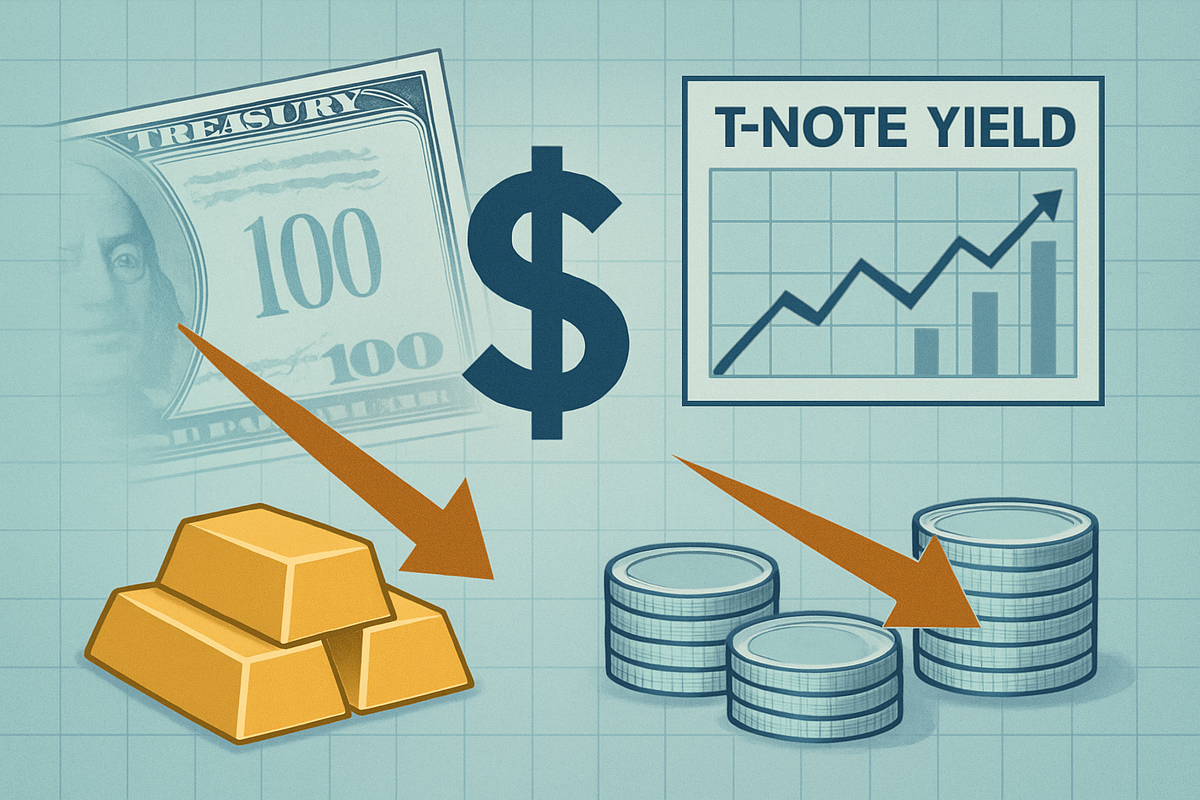
The financial markets are currently grappling with the notable ascent in U.S. Treasury note yields, a development that is sending significant ripples through global currency and commodity markets. As of November 3, 2025, the 10-year T-note yield has climbed to 4.11%, marking a 0.03 percentage point increase from the previous session and hovering near three-week highs, while the 2-year T-note yield stands at 3.59%. This upward trajectory in yields is primarily driven by persistent inflation concerns, the Federal Reserve's unwavering "higher-for-longer" interest rate policy, and anxieties surrounding the U.S. fiscal outlook.
The immediate consequence of these rising yields is a discernible strengthening of the U.S. dollar. Higher yields make dollar-denominated assets, particularly U.S. Treasuries, more appealing to international investors, thereby increasing demand for the greenback. Conversely, this dynamic exerts downward pressure on the prices of precious metals like gold and silver. The increased opportunity cost of holding non-yielding assets such as gold and silver, when compared to the attractive returns offered by interest-bearing Treasury notes, prompts investors to reallocate capital, leading to a notable decline in their market values. Recent observations have shown gold prices falling by approximately 4.52% and silver by 3.36% amidst this yield surge and dollar strength.
Detailed Coverage: The Mechanics Behind the Market Shift
The recent surge in T-note yields, particularly the 10-year Treasury note, has been a dynamic process shaped by a confluence of economic factors and central bank policy. On November 3, 2025, the 10-year T-note yield climbed by +2.7 basis points (bp) to 4.11%, building on an earlier rise to 4.094% on October 30, 2025. This current level is near three-week highs, though it's worth noting that the yield had previously touched a low of 3.87% on April 4th before surging to 4.59% by April 11th. A more significant upward trend was observed since December 6, 2024, pushing the 10-year yield to approximately 4.7% by January 7, 2025, marking its highest level since May 2024.
Several key drivers are behind this upward momentum. The Federal Reserve, a primary stakeholder, has played a pivotal role. Despite the Federal Open Market Committee (FOMC) lowering the target range for the federal funds rate by 25 basis points to 3.75%-4% on October 29, 2025, Chair Jerome Powell's hawkish stance at the subsequent press conference was a major catalyst. His warning in late October/early November that another rate cut in December was "not a foregone conclusion" sent a clear message to the market, pushing bond investors to demand higher yields. The Fed also announced its intention to conclude its balance sheet reduction on December 1, 2025, and plans to actively purchase T-bills to manage reserves.
Beyond monetary policy, persistent inflationary pressures continue to fuel the yield increases. With the July Consumer Price Index (CPI) reading at 3.8%, still above the Fed's 2% target, and core inflation projected to remain sticky between 2.5% and 3.5% in 2025, investors are demanding higher yields to compensate for the erosion of purchasing power. Robust U.S. economic indicators, including positive reports from the ISM manufacturing and services sectors and strong GDP growth forecasts (2.5% for 2024 and above 3.0% for 2025), further contribute to the belief that the economy can withstand higher rates. Other contributing factors include policy uncertainty, deleveraging by hedge funds, softening foreign demand for U.S. Treasuries, and concerns over fiscal sustainability, including the ongoing U.S. government shutdown.
Comparing current yields to historical averages provides context. While the 10-year T-note yield at 4.11% on November 3, 2025, is lower than its all-time high of 15.82% in September 1981, it is considered elevated compared to the levels observed in the mid-2010s. Forecasts suggest that the 10-year Treasury bond could potentially reach between 5.0% and 6.0% by the end of 2025. In terms of immediate market reactions, the U.S. dollar index (DXY00) saw a slight increase on November 3, 2025, buoyed by the rising yields and Powell's statements, even reaching a fresh two-week high after the Fed's rate cut. However, the dollar has also faced headwinds from the government shutdown and weaker manufacturing PMI reports. In the commodity markets, gold (GCZ25) experienced some bargain hunting on November 3, closing up +0.44%, despite the overall bearish pressure from a stronger dollar and higher yields. Interestingly, gold surged to record highs above $3,500 in early September 2025 amidst rising yields and market uncertainty, a "paradoxical" move also supported by increased global central bank gold purchases. Silver (SIZ25) closed down -0.23% on November 3, undercut by weaker U.S. PMI reports, though it too saw strong performance in early September, reaching $40.75.
Company Impact: Winners and Losers in a High-Yield Environment
The dual forces of rising T-note yields and a strengthening U.S. dollar create a distinct landscape of winners and losers across various corporate sectors. Companies face increased borrowing costs, shifts in export competitiveness, and altered commodity price dynamics, directly impacting their profitability and strategic outlook.
The banking sector generally emerges as a beneficiary in this environment. As T-note yields climb, interest rates on various loans—from mortgages to business lines of credit—tend to follow suit, expanding banks' Net Interest Margins (NIMs). This widens the spread between what banks earn on assets and pay on deposits, boosting net interest income. A stronger dollar also attracts foreign investment into U.S. assets, including U.S. banks. Large, diversified institutions like Bank of America (NYSE: BAC), JPMorgan Chase (NYSE: JPM), Citigroup (NYSE: C), and Goldman Sachs Group (NYSE: GS) are well-positioned to capitalize on these trends due to their extensive lending operations and global reach. However, these benefits are not without risks, as rising rates can also lead to depreciation in banks' existing bond portfolios and an increase in credit risk if higher borrowing costs strain borrowers' ability to repay.
Conversely, the technology sector, particularly high-growth companies with significant international revenue or reliance on debt financing, often finds itself on the losing side. Tech stocks are frequently valued based on future earnings, and rising T-note yields increase the discount rate used to calculate the present value of these future cash flows, making them less attractive and potentially leading to lower stock valuations. Furthermore, many tech companies rely on debt to fund research and development (R&D) and expansion; higher interest rates make this borrowing more expensive, squeezing margins and potentially slowing growth. Multinational tech giants such as Apple (NASDAQ: AAPL), Microsoft (NASDAQ: MSFT), and Meta (NASDAQ: META), which derive a substantial portion of their revenue from overseas, face translation risk, where foreign earnings convert into fewer U.S. dollars.
The manufacturing sector presents a mixed picture. U.S. manufacturers that export a significant portion of their products or face intense competition from imports are likely to suffer. A stronger dollar makes U.S.-produced goods more expensive for foreign buyers, reducing export demand, while simultaneously making imports cheaper, increasing competitive pressure domestically. Companies like Procter & Gamble (NYSE: PG), a global consumer products maker, has historically seen sales negatively impacted by an unfavorable dollar. Industries such as automotive and aerospace, with substantial export components, can also be negatively affected. However, manufacturers that heavily rely on imported components or raw materials can benefit from a stronger dollar, which makes these inputs cheaper. For instance, Generac Holdings (NYSE: GNRC), a Wisconsin-based manufacturer, has reported finding better prices for imported parts.
Finally, the precious metals mining sector is typically a clear loser in an environment of rising T-note yields and a stronger U.S. dollar. Gold and silver, priced globally in U.S. dollars, become more expensive for foreign buyers when the dollar strengthens, dampening demand and driving down prices. Moreover, rising T-note yields offer investors an alternative, yield-bearing "safe haven" asset, reducing the appeal of non-yielding assets like gold and silver. This diversion of investment flows away from precious metals directly pressures the profit margins of mining companies. Major players like Barrick Gold (NYSE: GOLD), Newmont (NYSE: NEM), and Pan American Silver (NASDAQ: PAAS) directly suffer from lower commodity prices, with smaller producers facing even greater challenges due to their leverage to commodity price movements. While some mining companies might incur costs in weaker currencies, this benefit is often offset by the overall decline in the dollar price of the commodity itself.
Wider Significance: Broader Trends and Historical Context
The current dynamics of rising T-note yields and a strengthening U.S. dollar extend far beyond immediate market reactions, shaping broader industry trends, global economic relationships, and policy considerations. This phenomenon is deeply intertwined with global monetary policy, inflation outlooks, and significant shifts in investment patterns.
One of the most profound implications is the divergence in global monetary policy. As the Federal Reserve either maintains elevated interest rates or signals further tightening, U.S. Treasuries offer increasingly attractive risk-free returns, drawing foreign capital into dollar-denominated assets. This influx strengthens the U.S. dollar and can compel other central banks, facing different domestic economic conditions, to react to potential currency depreciation or capital outflows. This creates a challenging environment for countries whose currencies weaken against the dollar, potentially exacerbating their inflation and making dollar-denominated debt more burdensome.
The inflation outlook is also significantly impacted. A stronger U.S. dollar can act as a deflationary force within the U.S. by making imports cheaper for American consumers and businesses. However, for countries heavily reliant on dollar-denominated imports, such as oil and other commodities, a strong dollar dramatically increases their import costs, fueling domestic inflation abroad. The rising T-note yields themselves can signal either robust economic growth, which typically comes with inflationary pressures, or a market demand for higher compensation due to persistent inflation fears.
This environment also precipitates major investment shifts. The allure of higher U.S. Treasury yields draws capital away from other markets, particularly emerging economies, in what is often termed a "flight to safety and yield." Global investors, including central banks and sovereign wealth funds, reallocate portfolios towards U.S. government bonds. The U.S. dollar's role as the dominant reserve currency means that any shift in Fed policy or U.S. economic outlook alters the opportunity cost of holding other currencies, directly influencing global investment flows and potentially destabilizing less robust economies.
From a regulatory and policy perspective, the rise in T-note yields presents significant challenges for the U.S. government's debt management. Higher yields directly translate into increased borrowing costs, escalating interest expenses on the national debt, which surpassed $36 trillion in 2025. This raises concerns about long-term fiscal solvency and discipline, potentially leading to a "debt spiral" where rising debt pushes interest rates higher, making the debt even more expensive. In terms of international trade policy, a stronger dollar disadvantages American manufacturers and exporters, potentially fueling political debates within the U.S. about the dollar's value and calls for policies to weaken it to boost domestic industries.
Historical precedents since 2022 offer valuable context. The Federal Reserve's aggressive interest rate hikes, initiated in March 2022 to combat inflation, contributed to a significant strengthening of the U.S. dollar, which appreciated by 20% since early 2021. U.S. Treasury yields also rose sharply during this period, with the 10-year yield more than doubling from early 2022 to May 2025. An inverted yield curve, observed from mid-2022 to late 2024, historically signaled expectations of a future economic slowdown. Experts have attributed the yield increases since 2022 to persistent inflation concerns, the growing U.S. national debt, and, in some instances, a reduced faith in U.S. economic and governmental institutions. However, a notable divergence in 2025 has seen surging U.S. Treasury yields sometimes accompanied by a weakening Dollar Index, which some analysts interpret not as a sign of economic strength, but as a "crisis of confidence" in U.S. fiscal health, driven by rising deficits and a potentially fading foreign appetite for Treasuries. This current market turmoil and selloff in U.S. Treasuries are seen by some as a U.S.-driven crisis, distinct from past events like 1998, with foreign investors liquidating dollar assets.
What Comes Next: Navigating Future Market Dynamics
The interplay between T-note yields, the U.S. dollar, and precious metals is poised for continued evolution, influenced by future Federal Reserve actions, the trajectory of inflation, global economic growth, and geopolitical events. Both investors and companies must prepare for a landscape of emerging opportunities and challenges, requiring strategic pivots and adaptations.
In the short-term (2025-2026), T-note yields are largely expected to trend lower as the Federal Reserve continues its rate-cutting cycle and has halted its Quantitative Tightening (QT) program, signaling a shift towards monetary easing. This easing, driven by concerns over a softening labor market and liquidity strains, typically translates to lower interest rates across the board. However, persistent inflation above the Fed's 2% target or stronger-than-expected economic data could temper the pace of these cuts. The U.S. dollar is broadly anticipated to experience softness, with some analysts predicting the Dollar Index (DXY) could fall to the mid-90s by Q4 2025 and potentially lower by mid-2026, as reduced interest rate differentials diminish the appeal of dollar-denominated assets. Conversely, gold and silver may find support. Gold, acting as a safe-haven and inflation hedge, tends to perform well during periods of economic uncertainty and declining real interest rates, while silver benefits from both its precious metal status and robust industrial demand.
Looking at the long-term (beyond 2026), the trajectory of T-note yields will hinge on the sustained inflation outlook. If inflation remains sticky, the Fed might be compelled to maintain a "higher-for-longer" stance, preventing a significant decline in yields. Conversely, prolonged periods of subdued global economic growth and successful inflation containment could lead to a sustained lower yield environment. The U.S. dollar faces structural challenges, including persistent overvaluation and fiscal pressures, though U.S. economic outperformance could provide underlying support. Gold's long-term bullish drivers include persistent inflation, spiraling U.S. debt, and continued central bank buying for diversification. Silver's long-term outlook appears particularly strong, driven by unprecedented industrial demand from the solar energy sector and electronics, with projections suggesting that solar industry growth alone could exhaust a significant portion of global silver reserves by 2050, leading to long-term supply constraints and potentially much higher prices. This industrial fundamental-driven bull market differentiates silver from gold, which is primarily an investment asset.
Strategic pivots for investors should include maintaining a diversified portfolio, continuing to utilize gold and silver as hedges against inflation, and closely monitoring real interest rates. Managing dollar exposure will be crucial, especially if the U.S. dollar's weakening trend continues. Investors should also consider increased exposure to silver, not just as a precious metal, but as a critical industrial commodity for green energy. For companies, active currency hedging is vital, particularly for those with significant international operations, to mitigate risks from expected U.S. dollar weakness. Businesses reliant on silver (e.g., electronics, solar panel manufacturers) must anticipate rising costs and consider long-term supply agreements or exploration of alternative materials. Lower borrowing costs, if T-note yields continue to fall, could encourage investment and expansion.
Market opportunities include potential rallies in precious metals if inflation persists or geopolitical instability escalates, and the unique long-term growth opportunity presented by silver's industrial boom. A declining T-note yield environment could also offer lower borrowing costs for companies and governments. However, challenges loom, such as persistent high inflation eroding purchasing power, risks associated with significant U.S. dollar weakness, yield curve volatility, and the potential for geopolitical "black swans" that trigger extreme market reactions. The looming threat of silver supply constraints also presents a long-term challenge for industries reliant on the metal.
Considering potential scenarios:
- Controlled Disinflation and Soft Landing: T-note yields gradually decline, the U.S. dollar experiences modest depreciation, and gold and silver are supported by inflation hedging and robust industrial demand.
- Persistent High Inflation (Stagflation): T-note yields remain elevated or rise further, the U.S. dollar could see short-term safe-haven strength but long-term pressure, and gold and silver perform strongly as inflation hedges.
- Global Economic Resurgence and Geopolitical De-escalation: T-note yields experience a moderate rise, the U.S. dollar weakens further, and while gold and silver might face selling pressure from diminished safe-haven demand, silver's industrial demand would soar.
These scenarios underscore the complex and interconnected nature of financial markets. Agility, continuous monitoring of economic and geopolitical factors, and adaptive strategies will be paramount for investors and companies navigating the evolving global financial landscape.
Comprehensive Wrap-up: Navigating the New Financial Tide
The recent dynamics surrounding rising T-note yields, a strengthening U.S. dollar, and their traditionally inverse impact on gold and silver present a complex and evolving narrative in the financial markets. While conventional wisdom dictates that higher yields and a stronger dollar should exert downward pressure on non-yielding precious metals, a nuanced assessment reveals a significant shift in investor behavior and underlying structural forces at play.
Key takeaways from this analysis highlight that historically, gold and silver become less attractive when U.S. Treasury yields rise, as investors seek higher returns from interest-bearing bonds. Similarly, a stronger U.S. dollar makes dollar-denominated precious metals more expensive for international buyers, dampening demand. This positive correlation between Treasury yields and the dollar, where higher yields attract foreign capital and strengthen the greenback, has been a consistent theme. However, a notable deviation has been observed, particularly between 2023 and 2025, where gold has demonstrated an ability to maintain an upward trajectory even amidst a strengthening dollar. This resilience is attributed to anticipated structural inflation, increasing skepticism towards traditional financial assets, significant strategic accumulation of gold reserves by non-Western central banks, and persistent geopolitical tensions and recession fears driving safe-haven demand.
Moving forward, the market assessment suggests a cautious sentiment, heavily influenced by the Federal Reserve's stance on interest rates, persistent inflation concerns, and ongoing geopolitical developments. Despite a recent rate cut, Chair Powell's cautionary remarks that further cuts are "not a foregone conclusion" have tempered investor optimism, contributing to a stronger dollar and rising bond yields, which in turn place pressure on bullion prices. Investor behavior appears to be evolving, with profit-taking observed after gold's recent highs, yet long-term structural drivers, such as central bank diversification away from the dollar and ballooning federal debt, continue to reinforce gold's appeal. Silver, too, has shown resilience, with forecasts suggesting continued gains if its robust industrial demand persists.
The significance and lasting impact of these dynamics underscore a period of unusual market behavior where traditional inverse relationships are being challenged by structural shifts in the global economy and an increased appetite for risk aversion. This suggests that gold may increasingly act as a potent hedge against inflation and geopolitical instability, potentially independent of short-term dollar strength or rising yields. This implies a more resilient floor for gold prices than previously assumed under similar macroeconomic conditions, fundamentally altering its perceived role in a diversified portfolio.
Investors should closely watch for several key indicators in the coming months. Federal Reserve policy statements and actions regarding interest rates will be crucial, as any indication of further rate cuts or a more dovish stance could provide significant support for gold and silver. Persistent inflation trends will likely continue to bolster the appeal of precious metals as a hedge against the erosion of purchasing power. U.S. economic data, including ISM Manufacturing PMI, employment figures, and GDP growth, will offer vital insights into the health of the U.S. economy and influence Fed policy expectations. Furthermore, ongoing geopolitical developments and the continued accumulation of gold by central banks, particularly from non-Western nations, could provide significant demand-side forces for gold prices. These intertwined factors will shape the trajectory of T-note yields, the U.S. dollar, and precious metals, requiring investors to adopt a vigilant and adaptable approach to navigate the evolving global financial landscape.
This content is intended for informational purposes only and is not financial advice





